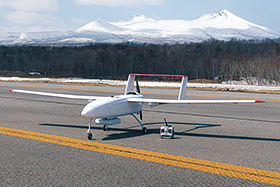Research & Development
JAXA promotes three research and development programs and a fundamental research program that underpins them.
Unmanned Airplane for Radiation Monitoring System (UARMS)
JAXA completes flight demonstration tests on its small unmanned aerial system for radiation monitoring
On March 7, JAXA conducted flight demonstration tests for its unmanned aircraft, equipped with radiation spectrometer technology developed by the Japan Atomic Energy Agency (JAEA), at Shikabe Airport in Hokkaido. The tests were designed to confirm and fine-tune the flight functionality of the small unmanned aircraft and validate the performance of the on-board radiation spectrometers. JAXA and JAEA have been working together since 2012 to create a radiation monitoring system using unmanned aircraft, which can fly at lower altitudes than manned aircraft and make close, detailed observations of the ground surface. JAXA's unmanned aircraft can also fly faster, longer, and farther than unmanned helicopters, thereby enabling monitoring of broader areas. The unmanned aircraft used for the March tests had a length of 2.7 m, a span of 4.2 m, a total height of 1.3 m, and a takeoff weight of 50 kg. Flying with a reciprocated engine and an auto-flight (program flight) system (disabled during takeoff and landing), the aircraft successfully met the intended basic functionality requirements. JAXA plans to improve the safety, reliability, and flight functionality of the aircraft to make unmanned aircraft-based radiation monitoring systems feasible for practical use.

March 8, 2013

